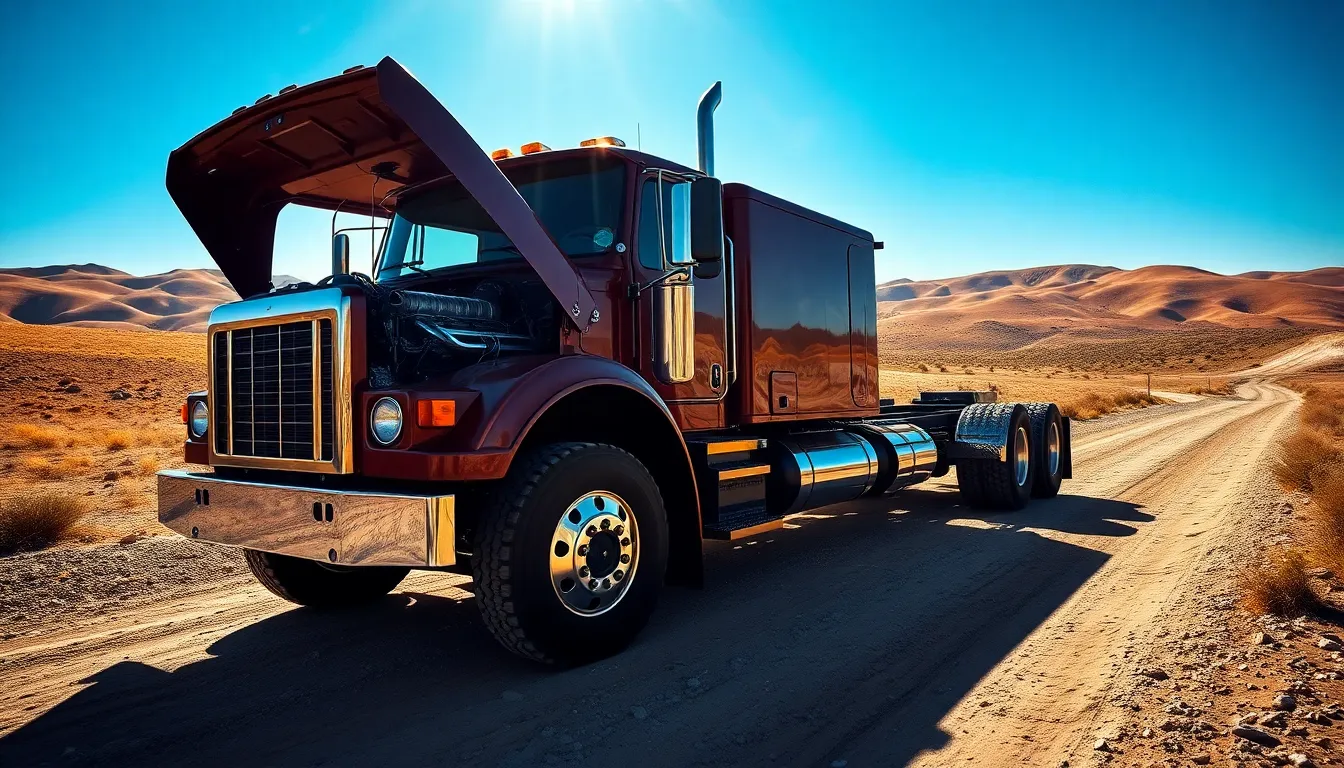Looking for the best truck engine and transmission combo for maximum performance? You’re not alone. Whether you’re hauling heavy loads or seeking optimal fuel efficiency, the right powertrain pairing can make all the difference in your truck’s capability and longevity.
The perfect engine-transmission combination balances power, reliability, and efficiency to meet your exact needs. Today’s market offers many options from traditional V8s paired with automatic transmissions to modern turbocharged engines coupled with sophisticated 10-speed gearboxes. Finding the ideal match depends on understanding how these components work together to deliver the performance characteristics you value most.
Understanding Truck Powertrain Dynamics
Truck powertrain dynamics involve the complex interplay between engine power and transmission efficiency that determines a vehicle’s overall performance. At its core, the powertrain transfers energy from the engine through the transmission to the wheels, creating the foundation for towing capacity, acceleration, and fuel economy. Different combinations of engines and transmissions produce vastly different driving experiences and capabilities.
Engine torque characteristics fundamentally shape how a truck performs under load. Low-end torque, typically measured at lower RPMs (1,200-2,000), provides the grunt necessary for towing heavy loads from a standstill. High-end horsepower, on the other hand, delivers sustained pulling power at highway speeds. Matching these engine output profiles with the right transmission ensures that power is available exactly when you need it.
Transmission gear ratios significantly impact both performance and efficiency in trucks. Lower gears (numerically higher ratios like 4.10:1) excel at multiplying torque for climbing and towing, while taller gears (like 3.23:1) reduce engine RPM during highway cruising for better fuel economy. Modern automatic transmissions with 8-10 speeds offer finer increments between gears, keeping the engine in its optimal power band regardless of driving conditions.
The weight-to-power ratio directly affects acceleration, towing capacity, and fuel consumption. Trucks with favorable weight-to-power ratios (lower numbers) respond more quickly to throttle inputs and generally feel more capable. This ratio becomes particularly important when selecting a powertrain for exact tasks—heavier loads demand more power to maintain the same level of performance.
Efficiency mapping reveals how engine and transmission pairings perform across different operating conditions. These maps show fuel consumption, power output, and thermal efficiency at various speeds and loads. The most effective powertrain combinations maintain high efficiency across a broader range of operating conditions, resulting in better real-industry fuel economy without sacrificing capability.
Top Diesel Engine and Transmission Combinations
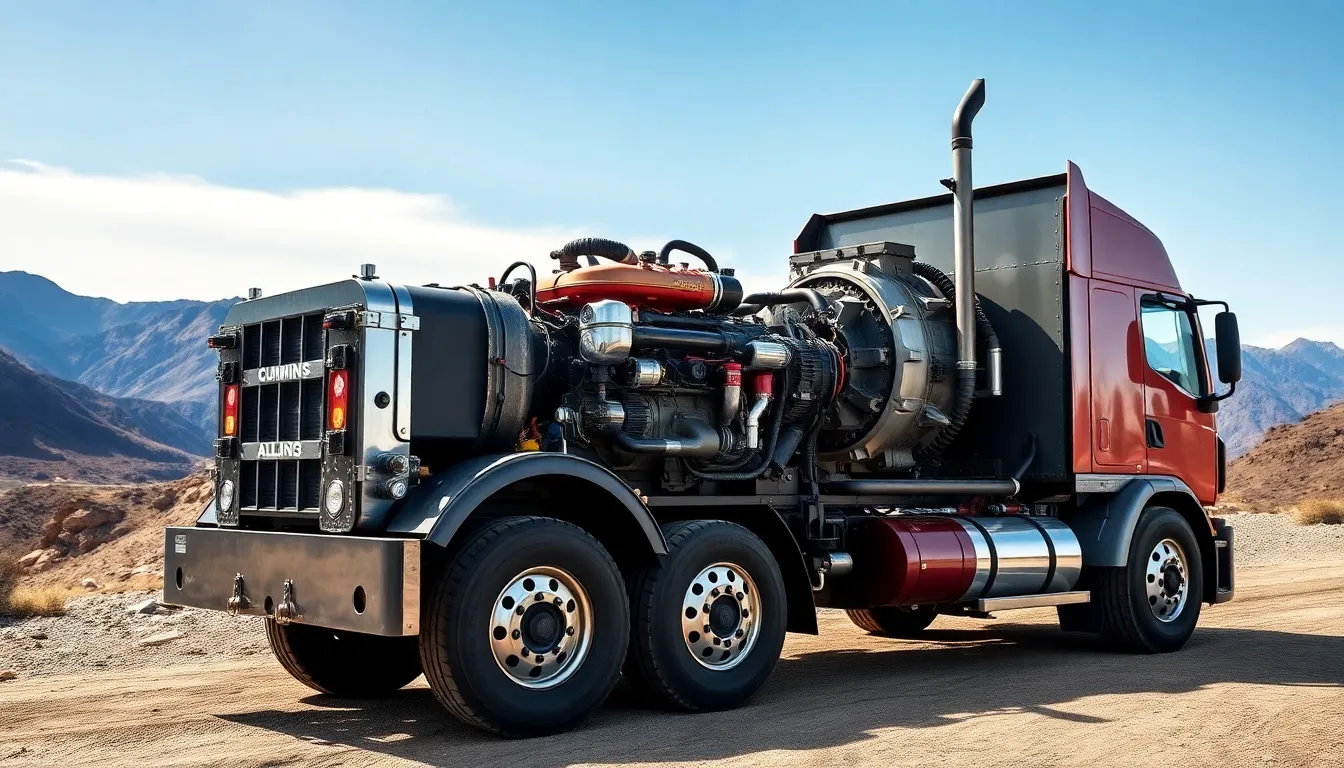
Diesel engine and transmission pairings significantly impact truck performance, with certain combinations standing out for their exceptional reliability and power. These legendary pairings have earned their reputation through decades of consistent performance in demanding conditions.
Cummins and Allison: The Legendary Duo
Cummins engines paired with Allison transmissions create one of the most respected powertrain combinations in the trucking industry. The 350 Cummins and Big Cam Cummins engines deliver outstanding performance metrics with remarkable longevity, often running for hundreds of thousands of miles with proper maintenance. Their robust construction handles continuous heavy loads while maintaining fuel efficiency across varied terrain. Allison transmissions complement these powerful engines perfectly with their exceptional torque management capabilities and smooth power delivery, creating a seamless driving experience even when hauling maximum loads. This combination excels in applications requiring sustained power output and reliability in challenging environments.
Duramax and Allison: GM’s Powerhouse Pairing
GM’s Duramax diesel engines matched with Allison transmissions form a formidable powertrain package renowned for balancing raw power with refined operation. Duramax engines deliver impressive fuel efficiency without compromising towing capacity or acceleration, making them ideal for both work and daily driving scenarios. Their advanced combustion technology provides excellent thermal efficiency while reducing emissions. The Allison transmission’s intelligent gear selection optimizes the Duramax’s power band, maintaining peak torque availability throughout the RPM range. This combination offers responsive performance with smooth gear transitions, establishing itself as a top choice for GM truck owners seeking dependable power delivery and long-term durability.
Other Notable Combinations
Several other powerful engine-transmission pairings deserve recognition for their exceptional performance characteristics. The 60 Series Detroit engines matched with Allison transmissions overcome common emissions system challenges while maintaining excellent reliability records. This combination provides consistent power delivery with minimal maintenance requirements, making it popular for fleet operations. CAT C15 and C16 engines paired with either Allison or Eaton transmissions create powertrains capable of handling extreme loads while offering driver-friendly operation. These combinations deliver outstanding torque multiplication for steep grades and heavy hauling applications, with documented cases of units exceeding one million miles in commercial service.
Ford’s Power Stroke and TorqShift Combination
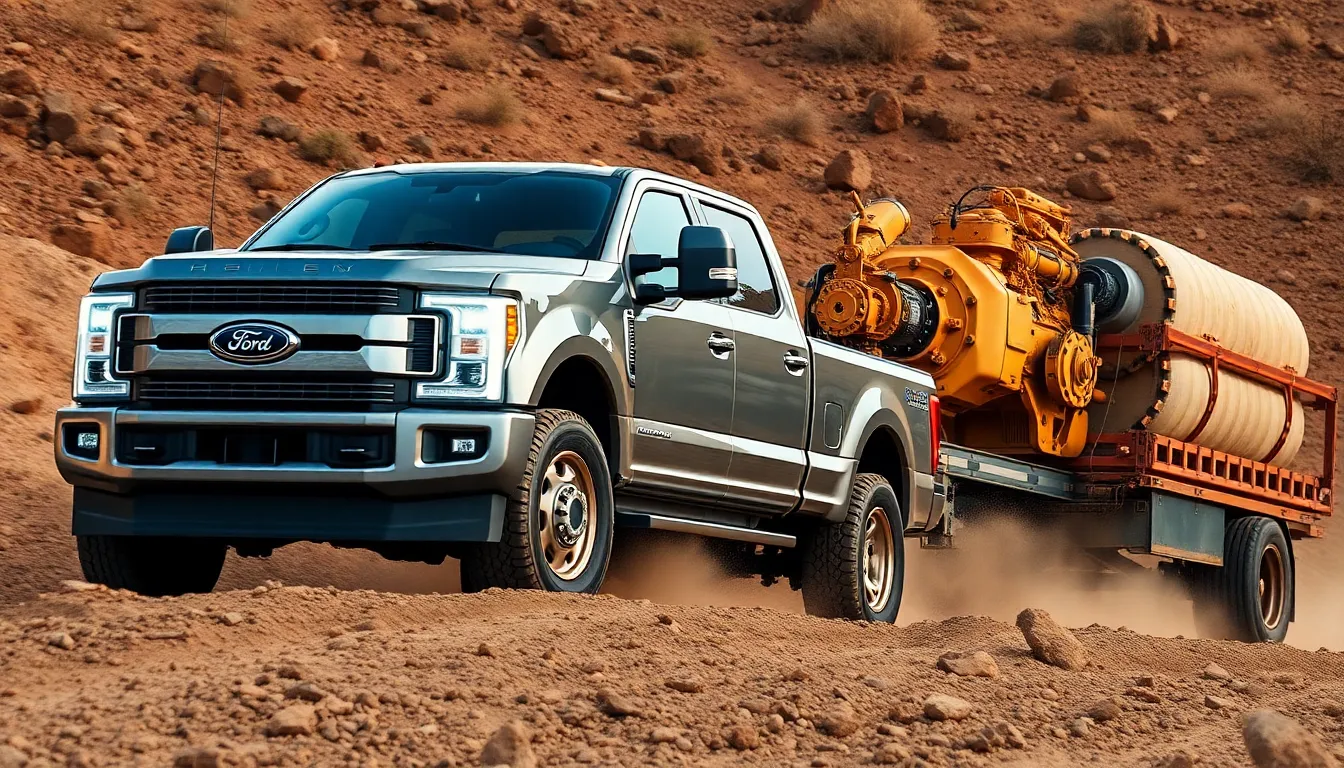
Ford’s Power Stroke engine paired with the TorqShift transmission represents one of the most formidable powertrain combinations in the heavy-duty truck market. This powerful duo has earned widespread recognition among trucking enthusiasts and fleet managers for its exceptional performance characteristics and long-term reliability.
The Power Stroke diesel engine delivers impressive torque and horsepower figures, making it perfectly suited for demanding tasks like heavy towing and hauling across challenging terrains. Its robust design enables consistent performance even under extreme conditions, a critical factor for commercial applications where downtime means lost revenue.
TorqShift transmissions complement the Power Stroke engine with precision-engineered electronic controls and durable construction. The 6-speed automatic transmission offers smooth gear transitions while effectively managing the substantial power output from the diesel engine. Truck owners particularly appreciate how this transmission optimizes fuel efficiency without sacrificing the raw power needed for heavy-duty applications.
Fleet operators choose this Ford combination for its proven track record of dependability over high mileage and extended service periods. The serviceability of both components makes maintenance more straightforward, reducing overall ownership costs compared to some competing options.
Though other notable pairings exist in the market—such as GM’s 6.6L gas engine with their 10-speed transmission or various Cummins engines matched with Allison transmissions—the Power Stroke and TorqShift combination stands out for heavy-duty truck applications. Its balanced approach to power delivery, fuel economy, and durability creates an ideal powertrain for commercial users who demand consistent performance day after day.
Trucking professionals consistently rank this Ford pairing among their top choices when performance and reliability cannot be compromised. The thoughtful engineering behind both the engine and transmission creates a seamless integration that maximizes the potential of Ford’s Super Duty trucks in the most demanding work environments.
RAM’s Hemi and ZF 8-Speed Integration
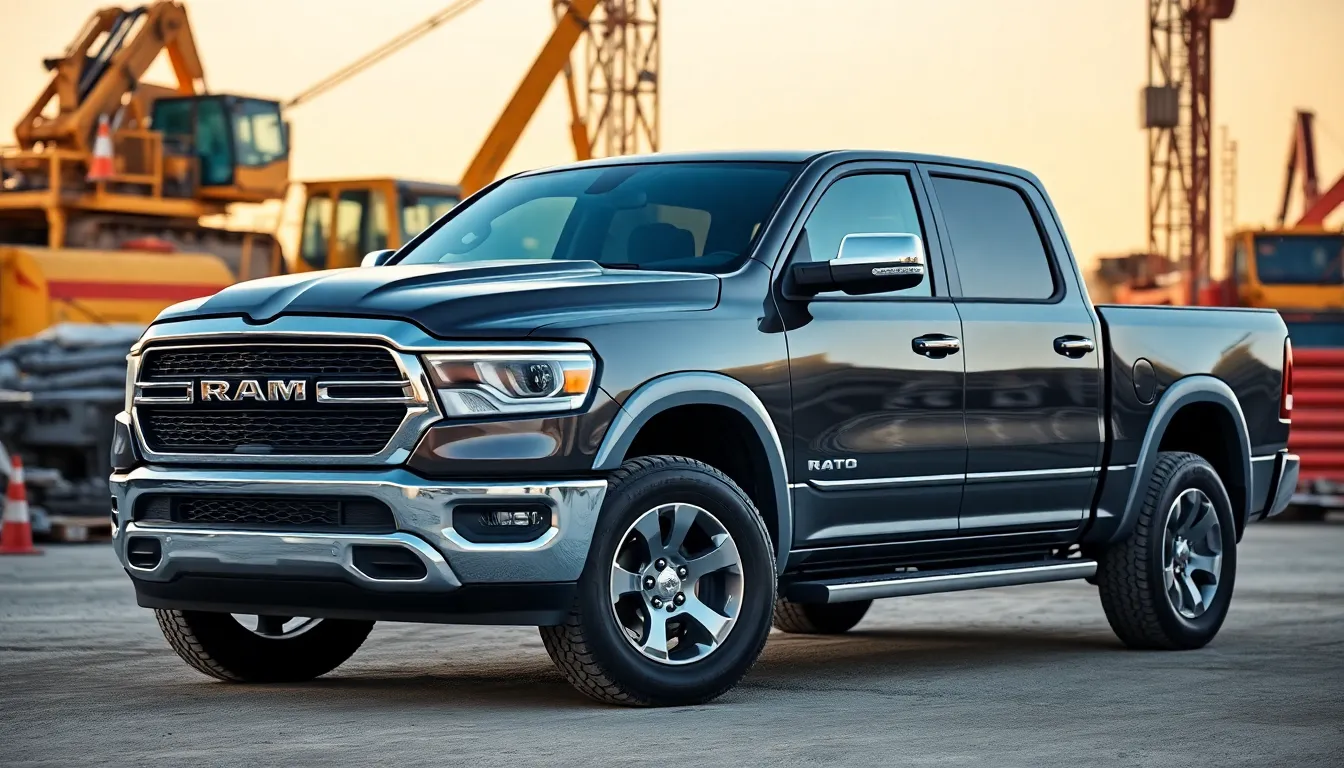
RAM’s integration of the 5.7-liter Hemi V8 engine with the ZF 8-speed automatic transmission creates one of the most balanced powertrain combinations available in modern pickup trucks. This pairing delivers exceptional performance characteristics that benefit both work capabilities and everyday driving scenarios. The Hemi V8 generates robust power and torque, making it perfectly suited for demanding hauling and towing tasks while maintaining impressive durability standards.
The ZF 8-speed automatic transmission complements the Hemi engine by providing seamless shifting that enhances the driving experience. Gear changes occur quickly and smoothly, optimizing power delivery across various driving conditions without the hunting or hesitation found in lesser transmissions. Many truck enthusiasts appreciate how this transmission helps improve fuel economy compared to older 6-speed automatics while simultaneously maintaining excellent responsiveness under load.
What sets this combination apart from competitors is the refined performance it delivers. The additional gear ratios in the ZF transmission allow the Hemi engine to operate more frequently in its optimal power band, resulting in a truck that feels both powerful and sophisticated. This transmission isn’t exclusive to RAM—it’s utilized across many premium trucks specifically because of its proven durability and performance characteristics in demanding applications.
When compared to industry alternatives, the RAM Hemi/ZF pairing offers distinct advantages. Ford’s offerings typically pair advanced transmissions with turbocharged V6 engines or electric motors in vehicles like the F-150 Lightning. GM trucks employ various engine options including a reliable 3.0L turbocharged inline-6 diesel, but their 10-speed automatics have experienced issues with harsh shifting and questionable reliability. The Hyundai Santa Cruz uses a smaller 2.5L inline-4 with an 8-speed automatic that works well for light-duty applications but lacks the capability needed for serious work.
For non-diesel gas engines in 2025 pickups, RAM’s Hemi and ZF 8-speed automatic transmission stands as a top-tier combination for reliability, power delivery, and transmission smoothness. This pairing has earned particular recognition for its longevity and superior towing capability compared to several competing options on the market.
Gas vs. Diesel: Which Powertrain Combo Reigns Supreme
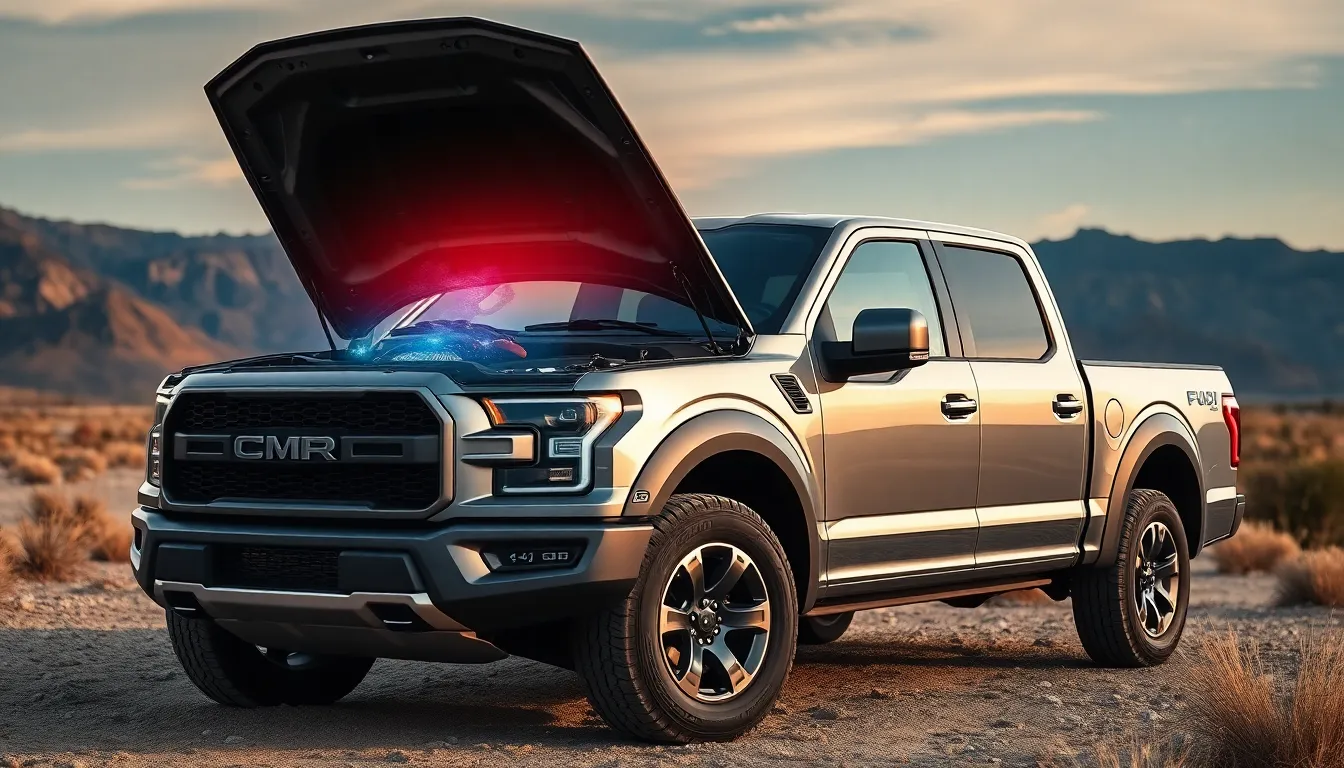
Gasoline Powertrain Advantages
Modern gasoline engines combined with advanced transmissions deliver impressive performance for many truck applications. GM’s 2500HD trucks feature a 6.6L gas engine paired with a 10-speed automatic transmission that provides reliable performance and exceptionally smooth shifting. These gas powertrains typically come with lower upfront costs compared to their diesel counterparts, making them more accessible for many buyers. Acceleration in gas-powered trucks tends to be more responsive, especially from a standstill. Maintenance requirements for gasoline engines are generally simpler and less expensive, with fewer specialized components to service or replace over time.
Diesel Powertrains for Heavy-Duty Applications
Diesel engines have earned their reputation for unmatched longevity, superior torque, and exceptional durability in demanding conditions. Classic powerplants like the Cummins 350, Caterpillar C15 and C16, and Detroit Diesel 60 Series consistently demonstrate remarkable robustness when handling severe workloads. Pairing these diesel engines with Allison automatic transmissions creates powertrains that excel in both acceleration and fuel economy for heavy-duty trucks. The Mack 300 HP and Big Cam Cummins diesel engines provide particularly reliable cold starts and extended service life, though they may sacrifice some fuel efficiency compared to newer models.
Real-Industry Performance Considerations
Selecting between gas and diesel powertrains eventually depends on your exact truck application and priorities. Newer Cummins and Paccar diesel engines have experienced reliability challenges related to modern emissions equipment, affecting their overall ranking compared to older, proven models. Allison transmissions consistently receive praise for their exceptional durability and efficiency when paired with heavy-duty diesel engines. For heavy hauling and long-term durability applications, a diesel engine from manufacturers like Cummins, Caterpillar, or Detroit Diesel combined with an Allison automatic transmission often represents the optimal combination.
| Powertrain Type | Best Applications | Key Advantages | Notable Combinations |
|---|---|---|---|
| Gasoline | Light-duty work, fleet trucks | Lower upfront cost, easier maintenance | GM 6.6L gas with 10-speed automatic |
| Diesel | Heavy hauling, long-term use | Superior torque, longevity, durability | Cummins/Caterpillar/Detroit with Allison automatic |
For fleet operators or those with lighter-duty requirements where initial investment and maintenance simplicity take priority, a gasoline engine paired with a modern multi-speed automatic transmission like GM’s 6.6L gas with 10-speed offers an excellent balance of performance and practicality. The perfect truck engine and transmission combination matches your vehicle’s intended purpose while balancing power needs, reliability expectations, fuel economy goals, and maintenance considerations.
Factors to Consider When Choosing Your Truck’s Powertrain

Selecting the optimal engine and transmission combination for your truck requires careful evaluation of several key factors. Your exact needs and usage patterns will eventually determine which powertrain delivers the best performance for your situation.
Towing and Payload Requirements
Towing capacity and payload capabilities stand as primary considerations when selecting your truck’s powertrain. Your engine and transmission must effectively handle your intended load, especially for commercial or heavy-duty applications. Heavy-duty needs demand powerful options like Ford’s 5.0L V8 or GM’s robust 6.2L V8. These engines perform exceptionally well when paired with sophisticated transmissions such as Ford’s 10-speed automatic or GM’s equivalent 10-speed automatic transmission. The combination creates a powertrain specifically engineered to manage substantial weight while maintaining performance. Trucks equipped with these powerful combinations easily handle trailers, equipment, and materials that would strain lesser powertrains.
Fuel Economy and Long-Term Costs
Fuel efficiency directly impacts your truck’s operating expenses over its lifetime. Many truck owners prioritize engines that balance power with reasonable fuel consumption, such as Ford’s 3.5L EcoBoost V6. This engine delivers impressive performance metrics while consuming less fuel than traditional V8 options. GM’s 5.3L V8 represents another popular choice, offering dependable performance characteristics with moderate fuel efficiency ratings. The transmission paired with these engines plays an equally important role in determining overall efficiency. Modern multi-speed transmissions optimize engine operation across various driving conditions, keeping the engine in its most efficient power band. Advanced transmissions with eight or more gears typically provide better fuel economy than older designs with fewer ratios.
Future Trends in Truck Engine and Transmission Technology
Electrification stands at the forefront of truck powertrain evolution, with manufacturers increasingly adopting electric and hybrid answers like the Ford F-150 Lightning. These electric powertrains deliver instant torque response, zero emissions, and towing capabilities that now compete effectively with traditional combustion engines. Automotive engineers continue refining multi-speed automatic transmissions beyond the current 10-speed configurations to optimize power delivery while improving both driving smoothness and fuel economy across operating conditions.
Torque management systems are becoming more sophisticated with smarter vectoring and all-wheel-drive technologies that significantly enhance traction in challenging terrain. These advanced systems maintain excellent handling agility and efficiency even when handling difficult off-road situations. Durability-focused engineering represents another major trend, with manufacturers emphasizing powertrain components specifically designed to exceed 200,000 miles of service life through improved cooling systems, stronger materials, and refined calibration that minimizes component wear.
Current benchmark combinations like the GM Silverado and Sierra 5.3L V8 (L82, L84, L87 engines) paired with their 10-speed automatic transmission demonstrate the direction of modern truck powertrains. This particular combination earns praise for its exceptional durability and smooth shifting characteristics, making it one of the most reliable options in the half-ton truck segment. Ford’s 3.5L EcoBoost V6 with its 10-speed automatic transmission similarly sets high standards for balancing power output with efficiency in full-size trucks.
Smaller but practical powertrain options are emerging for drivers who prioritize urban utility, exemplified by the Hyundai Santa Cruz with its 2.5L inline-4 engine (available in both naturally aspirated and turbocharged configurations) paired with an 8-speed automatic transmission. This combination offers impressive agility and reasonable towing capability of up to 5,000 pounds in higher trim levels while maintaining everyday driveability that traditional truck powertrains sometimes lack.
Conclusion
Finding your perfect truck powertrain is about matching capability to your exact needs. The right engine-transmission combo delivers more than just power—it provides reliability and efficiency customized to your driving demands.
Whether you’re drawn to the legendary Cummins-Allison pairing the Ford Power Stroke with TorqShift or RAM’s Hemi V8 with ZF 8-speed automatic each combination offers distinct advantages. Consider your towing requirements fuel economy goals and maintenance preferences when making your selection.
As truck technology evolves with electrification and advanced transmissions the fundamentals remain unchanged: the best powertrain matches your work requirements while balancing power efficiency and longevity. Your ideal truck isn’t just about what’s under the hood but how those components work together to serve your needs.
Frequently Asked Questions
What factors should I consider when choosing a truck engine and transmission?
Consider your towing and payload requirements first, as these determine the power needed. Evaluate fuel economy and long-term costs, balancing performance with efficiency. Think about reliability expectations, maintenance requirements, and your typical driving conditions. The right combination depends on whether you prioritize heavy hauling capacity, daily drivability, or fuel efficiency.
How do diesel and gasoline truck powertrains compare?
Diesel engines offer superior torque, unmatched longevity, and better fuel efficiency under load, making them ideal for heavy hauling and towing. Gasoline engines typically have lower upfront costs, simpler maintenance, and better cold-weather performance. Modern gas engines with advanced transmissions (like GM’s 6.6L with 10-speed automatic) have narrowed the performance gap, though diesels still excel in durability and pulling power.
What is the most reliable diesel engine and transmission combination?
The Cummins engine paired with Allison transmission stands out for exceptional reliability and longevity in heavy-duty applications. The Duramax-Allison combination also earns high marks for balancing power with fuel efficiency. For Ford trucks, the Power Stroke engine with TorqShift transmission delivers impressive dependability for commercial use, while CAT C15/C16 engines with Eaton or Allison transmissions are legendary for durability in demanding conditions.
How does the transmission affect truck performance?
Transmissions significantly impact overall truck performance by determining how engine power reaches the wheels. Proper gear ratios enhance towing capability (lower gears) and fuel economy (higher gears). Modern multi-speed automatics (8-10 speeds) optimize engine efficiency across driving conditions, providing better acceleration and reduced fuel consumption. The transmission’s ability to match engine torque characteristics affects smoothness, responsiveness, and the truck’s ability to maintain speed under load.
What is RAM’s most effective engine-transmission pairing?
RAM’s 5.7-liter Hemi V8 engine paired with the ZF 8-speed automatic transmission creates an exceptionally balanced powertrain. This combination delivers robust power and torque for demanding tasks while maintaining reliability. The ZF 8-speed enhances the driving experience with seamless shifting and improved fuel economy compared to older transmissions. This pairing outperforms many competitors in terms of longevity, towing capability, and smooth operation.
How does weight-to-power ratio affect truck performance?
Weight-to-power ratio directly impacts a truck’s acceleration, towing capacity, and overall capability. A lower ratio (more power relative to weight) results in better acceleration and improved towing performance. Heavier trucks require more powerful engines to maintain performance levels. This ratio is critical when selecting a powertrain that can efficiently move the truck’s weight plus its intended payload without struggling or compromising fuel economy.
What future trends are emerging in truck powertrain technology?
Electrification is the dominant trend, with fully electric trucks like the Ford F-150 Lightning offering instant torque and zero emissions. Hybrid powertrains are becoming common, combining traditional engines with electric motors. Advanced automatic transmissions with 8-10 speeds are standard, featuring sophisticated torque management systems. Manufacturers are focusing on improved durability, with powertrains designed to exceed 200,000-mile service lives, and smaller, more efficient options for urban utility without sacrificing capability.
How do Ford’s Power Stroke and TorqShift combination perform?
Ford’s Power Stroke engine paired with the TorqShift transmission is one of the most formidable powertrain combinations in heavy-duty trucks. This pairing delivers impressive torque and horsepower, making it ideal for heavy towing and hauling. The TorqShift provides smooth gear transitions and optimized fuel efficiency. Fleet operators favor this combination for its dependability and ease of maintenance, delivering consistent performance in demanding environments.
Are smaller truck powertrains effective for light-duty use?
Yes, smaller powertrains like the Hyundai Santa Cruz’s 2.5L inline-4 engine are highly effective for light-duty and urban use. These compact combinations offer sufficient power for occasional towing (up to 5,000 pounds) while delivering superior fuel economy and maneuverability. Modern small-displacement engines often feature turbocharging to provide adequate torque when needed. For users who prioritize daily drivability and efficiency over maximum towing capacity, these smaller powertrains represent an excellent balance.
How does efficiency mapping help in choosing the right truck powertrain?
Efficiency mapping illustrates how different powertrain combinations perform under various conditions. These maps show the “sweet spots” where an engine-transmission pairing operates most efficiently. By understanding this data, buyers can select powertrains that match their typical driving patterns. For example, someone who frequently tows heavy loads would benefit from a powertrain with efficient operation under high-load conditions, while someone focused on highway driving would prioritize efficiency at cruising speeds.
